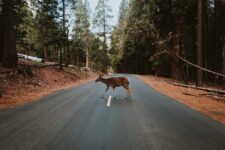
Drone-based Roadkill Prevention – DRONELIFE
Kumoh Institute of Technology’s drone-based system coordinates with ground vehicles to prevent animal crossings and reduce roadkill, potentially saving millions of animals worldwide.
by DRONELIFE Staff Writer Ian J. McNab
The South Korean research and development university Kumoh Institute of Technology recently applied for a new patent for an innovative use of UAVs- keeping wildlife away from roadways by using drones. The patent (serial #WO2023132426) describes coordinating a drone with a ground-based vehicle by a central server to physically block animals from ingressing into roadways.
As roads continue to cross the globe, intersecting with nature, it has become increasingly clear that cars and wild animals are simply incompatible. According to an estimate by Scientific American, up to 350 million vertebrate animals die per year in the US alone due to roadway intrusion, a massive number that has begun to threaten some vulnerable species, literally “driving” them to extinction. South Korean studies suggest that the issue remains prevalent there as well, with the water deer (Hydropotes inermis) and wild boar suffering the highest casualty rate, especially in Gangwon Province, causing damage to vehicles and natural populations alike.
As community researchers have begun to gather more data on roadkill, there’s been a new focus on innovative new ways to protect animals, including drones. The patent’s brief reads as follows, “The present invention relates to a road-kill prevention system capable of tracking wild animals and blocking entry thereof to a road entry using a drone, characterized by comprising: a drone formed to detect wild animals by surveying an area near a road where wild animals appear; a control server that receives location information of a wild animal detected by the drone and provides guidance regarding the location information of the wild animal; and a vehicle formed to be capable of driving on the road and receiving the location information of the wild animal from the control server and transmitting same to the surrounding area.”
This essentially describes a system where a drone is used to monitor a potential “problem area”, where there are an unusual number of crossings of roadways by wildlife, and coordinates with a ground-based vehicle that responds to animal crossings to ensure the safety of both passing vehicles and the animals at risk of being hit. Over time, this method could potentially save the lives of millions of animals worldwide, making it a little easier to live alongside “wild” environments.
Read more:
Miriam McNabb is the Editor-in-Chief of DRONELIFE and CEO of JobForDrones, a professional drone services marketplace, and a fascinated observer of the emerging drone industry and the regulatory environment for drones. Miriam has penned over 3,000 articles focused on the commercial drone space and is an international speaker and recognized figure in the industry. Miriam has a degree from the University of Chicago and over 20 years of experience in high tech sales and marketing for new technologies.
For drone industry consulting or writing, Email Miriam.
TWITTER:@spaldingbarker
Subscribe to DroneLife here.



